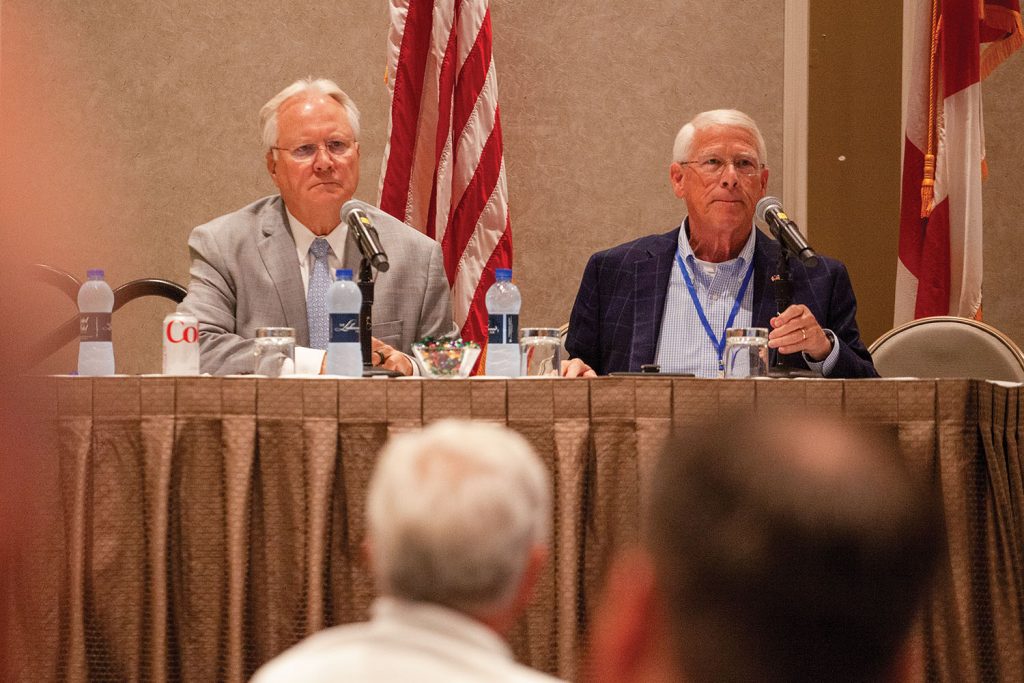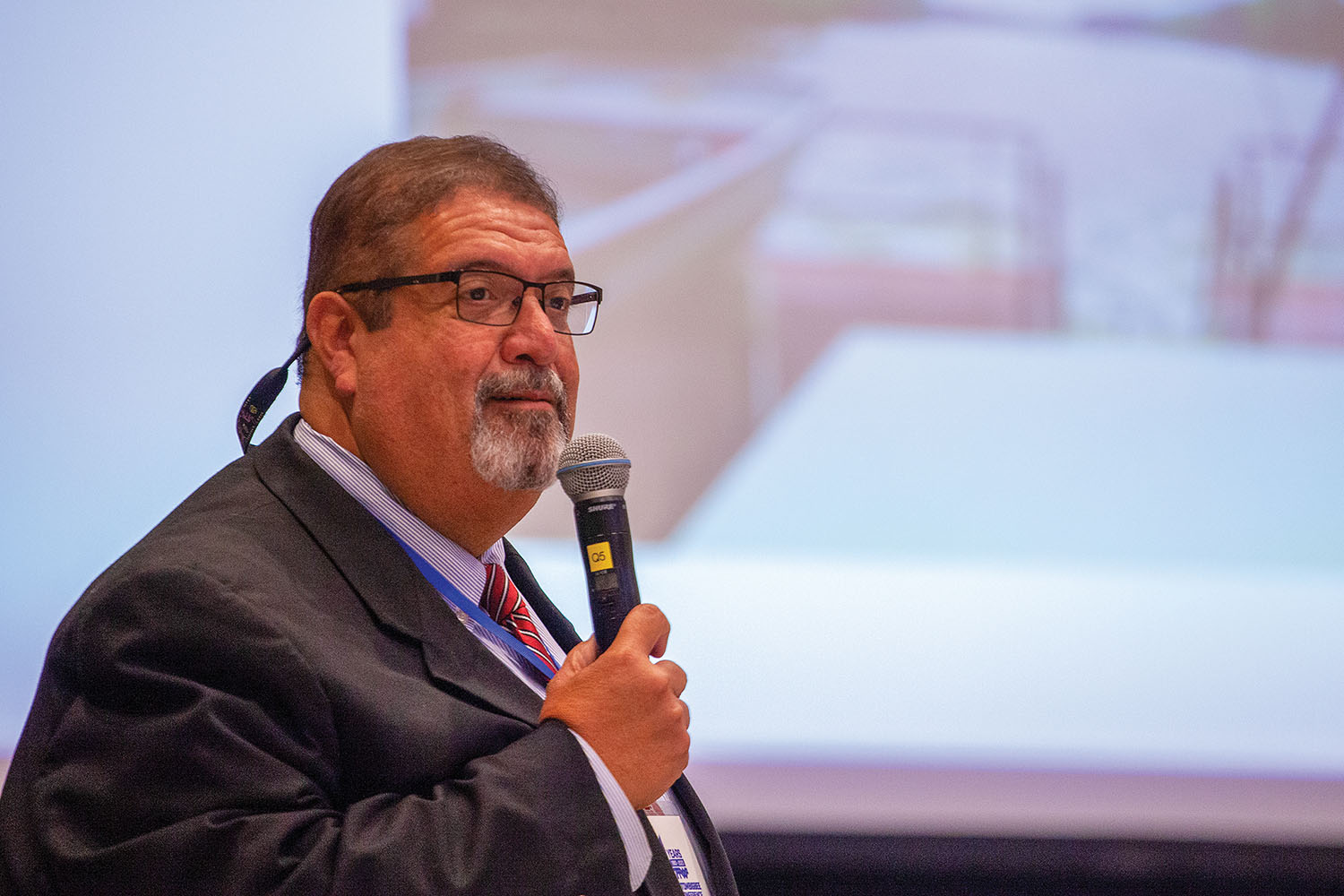Managers, operators and stakeholders of the Tennessee-Tombigbee Waterway (Tenn-Tom) gathered in Point Clear, Ala., on the eastern shore of Mobile Bay August 9–11 at the Grand Hotel for the 41st annual Tennessee-Tombigbee Waterway Conference, hosted by the Tenn-Tom Waterway Development Authority and its sister organization, the Tenn-Tom Waterway Development Council.
The authority, established by the U.S. Congress in 1958, is a four-state compact made up of the governors of Alabama, Kentucky, Mississippi and Tennessee, along with five gubernatorial appointees. The council, founded in 1984 through a resolution of the authority, is a non-profit organization made up of waterway stakeholders.
Following a golf scramble August 9, conference attendees reconvened the following morning for the two-day conference. By all accounts, it was the largest crowd in recent memory.
“We had over 230 attendees,” said Mitch Mays, who serves as administrator of the authority and president of the council. “It was the biggest turnout since I’ve been with the Tennessee-Tombigbee Waterway Development Authority.”
A central part of the conference, as always, was the reports from representatives of both the Mobile and Nashville Engineer Districts.
Nelson Sanchez, operations division chief for the Mobile District, began his report by outlining how both waterways that include the Tombigbee River, the Tenn-Tom and the Black Warrior-Tombigbee Waterway (BWT), are in good standing from a funding and maintenance standpoint.
“We’ve got some really good years coming up,” Sanchez said. “We had a very healthy FY23 budget year, and the president’s budget for FY24, as you can see, is really good for the Tenn-Tom, as it relates to earmarks and the BIL (Bipartisan Infrastructure Law), along with regular O&M.”
Just under $24 million was set aside for the Tenn-Tom in the FY23 budget, and the FY24 president’s budget ups that amount to $29.7 million. Just under $67 million in FY24 is slated for the Tenn-Tom from the BIL and earmarks, commonly referred to as community project funding requests. For FY23, the BWT received $59.7 million in funding, while the FY24 president’s budget sets aside just over $22 million for the waterway. Earmarks and BIL funding for the BWT in the current fiscal year stand at about $27.7 million.
The Tenn-Tom’s new administrative building in Columbus, Miss., will come online soon, as will the waterway’s new crane barge, which has been under construction at Thoma-Sea shipyard in Lockport, La. BWT managers expect to award a contract for their new administrative building in Tuscaloosa, Ala., in the fourth quarter of this year.
Other major projects receiving funding include new lower miter gates for Demopolis and Coffeeville locks on the Tombigbee River, advanced dredging work for Sunflower bar on the BWT and upland disposal area maintenance on the Tenn-Tom.
“We have all upland disposal areas, so when we dredge, it all has to go outside the channel,” said Justin Murphree, project manager for the Tenn-Tom. “Our disposal areas over the years have been getting full. We do [disposal area] maintenance each year to try to create space, but there’s only so much we can create.”
The vast majority of the BIL funds going to the Tenn-Tom in FY24—$63 million—will go toward creating more upland disposal capacity by hauling out dredge material.
“We’re going to get rid of a lot of that material,” Murphree said. “We’re still working on acquisition strategy and exactly how we’re going to do it, but at least we’ve got the funding coming.”

Lock closures on the horizon for the Tenn-Tom will take place at Wilkins and Cochran locks in 2024, with closures planned for Whitten Lock in 2025 and Aberdeen and Stennis in 2026. The work at Whitten Lock will include permanent repairs to the lock’s culverts, which have seen chronic concrete fatigue.
Just recently, Murphree and his team completed repairs at the Stennis Dam spillway, following the sinking of a barge in June 2021 that caused a scour hole on the lower end of the dam. The scour hole reached as much as 30 feet deep, Murphree estimated.
Anthony Perkins, project manager for the BWT, said he anticipates maintenance closures at Demopolis and Coffeeville locks in 2026 and 2027, respectively. The design work is complete on the replacement miter gate leafs for Demopolis, with a possible contract award next year.
Jeremy LaDart, chief of the planning and environmental division for the Mobile District, also outlined status of the deepening study for the Tenn-Tom and BWT, which will explore the feasibility of taking those waterways from an operating depth of 9 feet to 12 feet.
“We’ve received two rounds of funding, thanks to Sen. Shelby before he retired and others, that’s totaled about $3 million,” LaDart said. “This is a total federal study.”
LaDart said the total cost of the study will be about $11 million, with an estimated time to completion of six years and three months. Part of the cost and lengthy term has to do with how many miles of waterway will be studied: 691 miles on both projects.
The Corps team is currently studying the engineering, economics and environmental impacts of the project.
“The engineering group is going out and they’re trying to look at depths between 10 and 12 feet, because we have to economically justify any depth we go to.”
LaDart said he’s hopeful the team will find that a notable amount of the 691 miles is already at 12 feet, which would impact the cost and the need for additional upland disposal capacity.
LaDart closed his presentation by discussing how important the economic picture is for establishing the feasibility of the project. That’s the portion of the study where industry has a significant role to play.
“We’ve got to know specifically what’s moving on the waterway, what will benefit as we deepen this, so that way we can help tell the story and justify moving forward on this,” he said.
LaDart said operators and stakeholders can reach out to Mays to identify ways to share that information.
Caption for top photo: Nelson Sanchez, operations division chief for the Mobile Engineer District. (photo by Frank McCormack)



